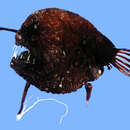en
names in breadcrumbs


View data on Catalog of Fishes here.
Dorsal profile of frontals nearly straight; sphenotic, preopercular, and angular spines sharp and well developed in juveniles, blunt and shorter in adults; juveniles with 8 or 9 premaxillary teeth, 6 or 7 dentary teeth, and a pair of vomerine teeth; adults with 17 or 18 premaxillary teeth, 11–16 dentary teeth, and two pairs of vomerine teeth; dorsal-fin rays 3; anal-fin rays 3; pectoral-fin rays 15 or 16.
Length of illicium 24.5–35% SL; tip of escal bulb smoothly rounded in adults, with a low transverse keel in 28.5-mm specimen (possibly caused by shrinkage); stout pair of tapering filaments on upper part of bulb, simple except for two tiny lateral branches on right filament of 185-mm specimen; a single pair of conical papillae on proximal part of bulb of 27-mm holotype, two pairs in adults, none in 28.5-mm specimen.
Barbel very similar in all three specimens in which it is retained; distal pair of branches truncated and short, length measured to base of filaments 3–5% SL; 28.5-mm specimen with medial branch about same length, with slender stem bearing two pairs of pear-shaped photophores, medial branch of 180-mm specimen much shorter, with about 10 internal photophores; medial branch of 185-mm specimen undeveloped or lost; all barbel filaments and stalked photophores unpigmented; dense pigmentation of stem of barbel extending onto two primary branches of adults, terminating proximal to bifurcation in juvenile specimen.
Caudal peduncle (examined in the holotype and the 18-mm parasitic male) with strong concentration of subdermal pigment.
Sphenotic spines of parasitic male small, but sharply pointed.
Metamorphosed females of Linophryne bicornis differ from those of all other species of the genus in details of escal and barbel morphology: escal bulb without distal prolongation or filaments, anterior and posterior appendages absent; a stout tapering filament on each side of upper part of escal bulb, each 1–1.5 times diameter of bulb; 0–2 minute conical papillae below each lateral filament. Primary stem of barbel undivided, length 20–32% SL; distal end divided into a pair of short branches, each with a lateral series of 3 or 4 long filaments, decreasing in length distally and gradually continuing as a cluster of stalked photophores on tip and medial side of each branch; each filament with a distal series of internal photophores; length of proximal and longest filaments 35–65% SL; a small branch with internal photophores in cleft between the pair of primary branches. Caudal peduncle with a dense concentration of subdermal pigment in 27-mm holotype and in parasitic males. Parasitic males with pointed sphenotic spines.
Three of the known females of Linophryne bicornis were caught in the Western North Atlantic, the 27- and 28.5-mm juveniles in open pelagic nets with maximum fishing depths of 1100–1200 m and at about the same position, 32°N, 64–65°W.
Bathydemersal, probably meso- and bathypelagic as well. The adult female with parasitic male from the Atlantic was caught in a commercial bottom trawl at 600–700 m off Newfoundland, while the second attached pair was collected in a bottom trawl at 1220–1272 m in the Eastern South Indian Ocean.
Pietsch TW. 2009. Oceanic Anglerfishes: Extraordinary Diversity in the Deep Sea. Berkley: University of California Press. 638 p.
Parasitized females have a single attached male, in contrast to the linophrynid genera Haplophryne and Borophryne (and the ceratiid genera Ceratias and Cryptopsaras) in which females with two or more males are known. In all known cases parasitized females of the family, the male is directed forward with respect to the female and attached in nearly the same position on the ventral midline of the female, somewhat in front of and below the sinistral anus; with only one or two exceptions, all are attached upside down with respect to the female. This is again in contrast to the linophrynid genera Haplophryne and Photocorynus (and the ceratiid genus Cryptopsaras) in which males may attach in any direction and almost anywhere on the head and body of the female. In all known examples, the males are attached by both upper and lower jaws, leaving prominent openings on each side that lead into their mouths and opercular cavities; there is no papilla of tissue projecting from the female into the mouth of the male.
Known from five metamorphosed females (27–185 mm) and three parasitic males (18–30 mm).
PAWNEE station 59, Bermuda, 32°19'N, 64°32'W, open pelagic net, about 2500 m of wire, 21 April 1927.
Holotype of Linophryne bicornis: BOC 2030, 27 mm.